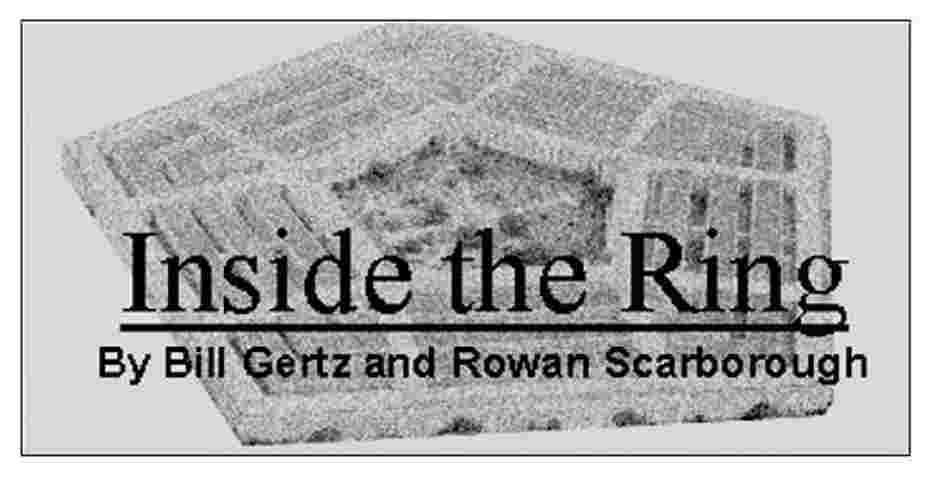|
Return to
|

|
February 27, 2004
Notes from the Pentagon
Covert warriors
Defense Secretary Donald H. Rumsfeld last year gave SoCom orders to plan missions to kill or capture al Qaeda terrorists around the world. Previously, SoCom was a supporting command, buying equipment and supervising training for the 40,000-strong special operations corps.
Now, the Tampa, Fla.-based command is combatant, or "supported," command. It has been putting together a battle staff to plan self-contained missions based on actionable intelligence developed by SoCom itself and the intelligence community.
Part of Mr. Rumsfeld's SoCom plan is for commandos, such as Army Green Berets, also called Special Forces, to collect their own intelligence.
In Gen. Dailey, SoCom would get a proven leader who commanded Joint Special Operations Command during the war in Afghanistan and later led commandos in the war to topple Saddam Hussein. Gen. Dailey is a hands-on commander and made frequent trips from JSOC headquarters at Fort Bragg, N.C., to help his teams of Army Delta Force soldiers and Navy SEALs.
Under the plan talked about in the Pentagon, Gen. Dailey would earn promotion to lieutenant general. Gen. Doug Brown, also a veteran of JSOC, is SoCom commander.
Tracking weapons
The program is led by John Shaw, the deputy undersecretary of defense for international technology security, who also is a Pentagon inspector general for international armament and trade through a memorandum of understanding with the Pentagon inspector general.
"We handle international technology-transfer issues, as well as the investigative side of things," said Edward Timperlake, the Pentagon's director of technology assessment, who works with Mr. Shaw.
The focus of the effort is not on weapons of mass destruction. Rather, the group is looking at conventional arms and dual-use items with commercial as well as military applications. The program began after Operation Iraqi Freedom, which uncovered huge stockpiles of foreign weapons in Iraq. The weapons came from a variety of suppliers, including Russia, France and China.
Iraq 'ebb and flow'
The transition from U.S. control to Iraqi leadership is set for July 1.
Depending on how hot different parts of Iraq remain in the coming months, "I think that what you'll see is that it will vary in different parts of the country over time and there will be an ebb and flow," Mr. Rumsfeld told reporters traveling with him in the Middle East.
"It may very well be in one section of the country, the military commander will make a judgment that they can move back and put the Iraqi forces out front, and that that will stick permanently. It may also be that in some parts of the country that will happen, and they'll make a judgment a month or two or three or four later that they need to press back in and support the Iraqi security forces and that you'll see that ebb and flowing for a period of time, I suspect."
Civvies
The assertion came after the spokesman was asked about a story in The Washington Times that Green Berets would take on more intelligence roles in the war on terror, including stints under diplomatic cover in some U.S. embassies. The idea is to get the lay of the land in some al Qaeda-infested country. Perhaps a Green Beret's network could finger some of Osama bin Laden's operatives for assassination.
When the spokesman was asked about the story, he said that they will not do anything in civilian clothes.
A Green Beret told us, "He doesn't know what he's talking about."
After the spokesman made the assertion, Larry Di Rita, the Pentagon's top spokesman, quickly added, "Let me pull back on that question. Would we do something that's contrary to military regulations and the law, is your question. And the answer is no."
Iraq chat
According to the Office of Naval Research, which helped develop the multilingual chat software, the communications link is a big hit.
The chat line is being used to communicate with the U.S. and allied Multi-National Division and Polish troops at Al Hilla, Spanish troops at Ad Diwaniyah, and Ukrainian troops at Al Kut. The Ukrainians are using Cyrillic characters on their chat system.
Ten laptops with the chat line were sent to Iraq in November. Now, about 200 are being used.
|
|
Inside the Ring Archives
1999 Columns 2000 Columns 2001 Columns 2002 Columns 2003 Columns 2004 Columns |